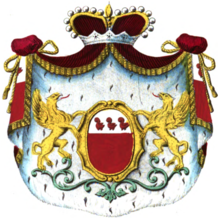Ursel (noble family)
Ursel is the name of a Belgian noble family . The head of the family bears the title Duke of Ursel and Hoboken , the other members the title Count or Countess d'Ursel.
History of the Ursel House
The family was originally called Schetz. Caspar Schetz is mentioned in Schmalkalden in Thuringia at the beginning of the 15th century , around 1480 the family moved to Hasselt (Belgium) and Maastricht . Erasmus Schetz (1476–1550) was - like his father Conrad († 1499) - mint master of the Prince-Bishop of Liège and founded an important trading company in Antwerp , which was involved in the sugar trade with Brazil and in the extraction of silica zinc in the mines of Kelmis . In 1545 he acquired the rule of Grobbendonk .
His older son Gaspard Schetz (1513–1580), a banker in Antwerp, became Chancellor of the Treasury of the Netherlands in 1560; he financed trade with Russia and Brazil and gave war credits to King Philip II of Spain ; he acquired the goods Wezemaal, Heist-op-den-Berg and Hingene . His second wife was Catherina van Ursel, daughter of the Antwerp mayor Lancelot van Ursel (1499–1573), whose family originally came from Ursel in East Flanders . Gaspard's eldest son, Lancelot Schetz (1550–1619), became mayor of Brussels, the second son Karel Schetz (1552–1590) Chancellor of the Order of the Golden Fleece, the fourth son Conrad Schetz (later Conrad I. van Ursel , 1553–1632) ), Lord of the Hunger and Envoy to Great Britain, was made Baron van Hoboken in 1600; In 1617 he was adopted by his aunt Barbara van Ursel and took her name. The youngest son, Anthonie Schetz (1561–1640), governor of 's-Hertogenbosch , rose to baron in 1602 and count of Grobbendonk in 1637; its branch expired in 1726 and ownership fell to the Ursel branch.
The son of Conrad van Ursel, Conrad II (1592–1659), lord of the Hermalle-sous-Huy Castle (in Engis ), became Count in 1638. His great-grandson Conrad Albert (1665–1738) became general and administrator of the Austrian Netherlands ; Emperor Charles VI. elevated him to Duke of Ursel and Hoboken in 1716 . His son Karl (1717–1775), the 2nd Duke, was an Austrian Lieutenant Field Marshal and Military Governor of Brussels. His grandson Charles-Joseph (1777-1860), 4th Duke, became a minister in the United Kingdom of the Netherlands and later a Belgian senator. His grandson Joseph (1848–1903) was Governor of Hainaut and President of the Belgian Senate. Various family members from the younger, Count's branches served as Belgian diplomats and civil servants.
The dukes of Ursel

- 1716–1738: Conrad Albert (1665–1738) ∞ Eleonore Princess of Salm
- 1738–1775: Karl (1717–1775) ∞ Princess Eleonore von Lobkowitz
- 1775–1804: Wolfgang Willem (1750–1804) ∞ Flore Princess von Arenberg
- 1804–1860: Charles-Joseph (1777–1860) ∞ Louise Ferrero Fieschi , Princess of Masserano
- 1860–1878: Léon (1805–1878) ∞ I. Sophie d ' Harcourt , ∞ II. Henriette d'Harcourt
- 1878–1903: Joseph (1848–1903) ∞ Antonine Comtesse de Mun
- 1903–1955: Robert (1873–1955) ∞ Sabine de Franqueville
- 1955–1974: Henri (1900–1974) ∞ Antoinette de la Trémoille
- 1974–1989: Antonin (1925–1989) ∞ Ursula Michaelsen
- 1989-present: Stéphane (* 1971) ∞ Catherine Bourguignon, son: Matisse (* 2001)
Well-known representatives
- Joseph d'Ursel (1848–1903), 6th Duke, politician
- Léon Léopold d'Ursel (1867–1934), Belgian ambassador
Possessions
Since 1595 the family owned a city palace, the Hôtel d'Ursel on the Loksumstraat, in Brussels. The Hoboken Castle near Antwerp and Hermalle-sous-Huy Castle in Engis were initially used as country houses (until the 18th century) . The Hingene summer residence, which has been in the family since 1608, was redesigned in baroque style for Duke Karl in 1761–1765 by the architect Giovanni Niccolò Servandoni (actually Jean-Nicolas Servan; 1695–1766); it has been owned by the Province of Antwerp since 1994.
The castles of Durbuy (since 1756), Heks (in Heers ), Linterpoorten (in Zemst ) and Gruuthuse (in Oostkamp ) are still owned by family members.
Hoboken Castle near Antwerp
Ursel Castle in Hingene , 1608-20. Century owned by the family
Durbuy Castle , owned since 1756
Castle Heks
Individual evidence
literature
- Genealogical manual of the princely houses , section "Ursel", Volume 50, Princely houses IX, CA Starke Verlag , Limburg an der Lahn, 1971
- A. LOUANT, L'origine de la famille d'Ursel , in: Annales du Congrès de Liège, 1968.
- A. LOUANT, Les d'Ursel de la branche anversoise en Brabant , in: Wavriensia, 1968.
- A. GRAFFART, Inventaire des archives de la famille d'Ursel , Brussel, Rijksarchief, 1998.
- Oscar COOMANS DE BRACHÈNE, État présent de la noblesse belge , Annuaire 2000, Brussel, 2000.
- Baudouin D'URSEL, Les Schetz. La Maison de Grobbendonk. La Maison d'Ursel , Recueil Office de Généalogie et d'Héraldique de Belgique, 2 vol., 2005.
- Humbert DE MARNIX DE SAINTE ALDEGONDE, État présent de la noblesse belge , Annuaire 2013, Brussel, 2013.








